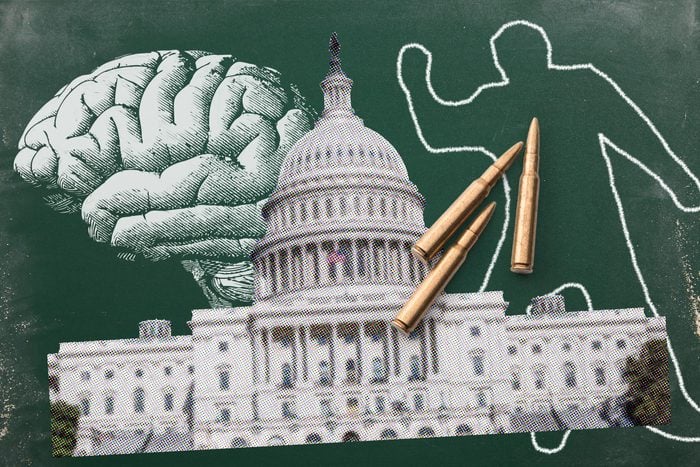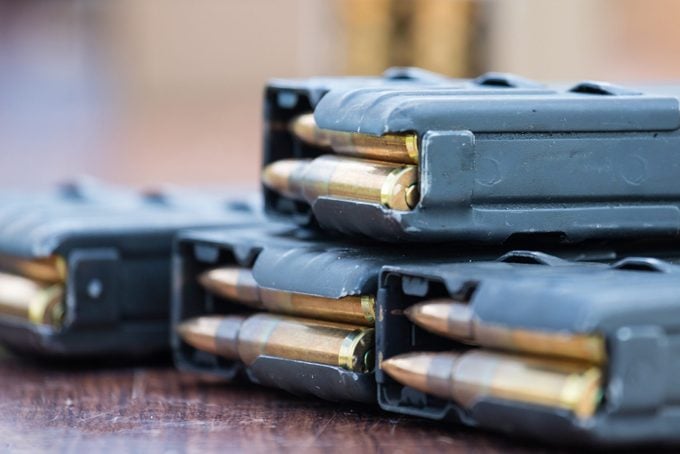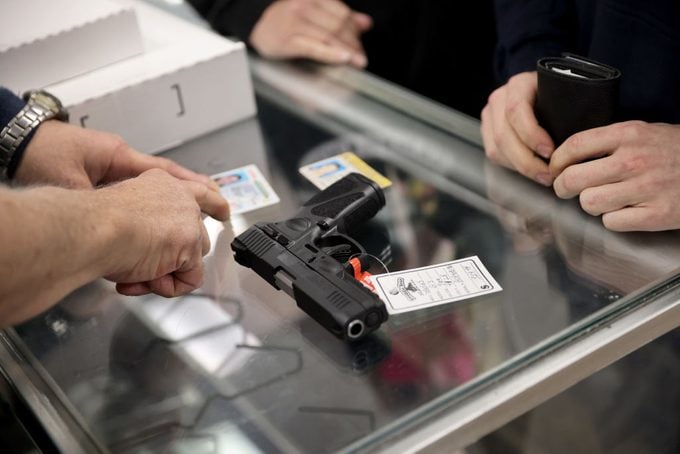What Are Commonsense Gun Laws—and How Can They Save Lives?
Updated: Mar. 27, 2023

What kind of commonsense gun laws would help stem the tide of gun violence while also respecting the rights of law-abiding gun owners? Here are some answers.
The Reader’s Digest Version:
|
On May 24, 18-year-old Salvador Ramos entered Robb Elementary School in Uvalde, Texas, armed with two legally purchased AR-15 rifles, a civilian model of the M-4 carbine used by U.S. armed forces. In about 90 minutes, he killed or mortally wounded 19 children aged 11 and younger, as well as two of their teachers. It was the 27th school shooting and the 213th mass shooting in the United States in the first five months of 2022—just 10 days after another 18-year-old man, reportedly motivated by White Replacement Theory, allegedly used a legally purchased AR-15-style rifle to murder 10 people in a Buffalo, New York, grocery store.
After each of these mass shootings, there was yet another news cycle of anguished loved ones, haunted survivors, and candlelight vigils. Another debate about why gun violence happens so often in America and why we seem unable to stop it. And another call for commonsense gun laws to rid our communities of weapons of war and keep deadly firearms out of the hands of those who cannot be trusted to use them responsibly.
With commonsense gun laws, we’re not talking about anything drastic like repealing the Second Amendment or changing the Constitution. Other countries dealing with similar tragedies have what we lack: national gun laws that prevent the type of gun violence that so often devastates our communities. But what are commonsense gun laws, exactly? That phrase is bandied about a lot, but most people don’t have a clear idea of what legislation would actually entail, even though recent polling suggests about 60 percent of Americans want Congress to pass stricter firearms regulations—and nearly 90 percent of Americans support some measures, such as strengthening background checks.
We spoke with experts to find out exactly what enacting commonsense gun laws would mean and how it could drastically reduce gun violence statistics in America.
What would commonsense gun laws look like?
On June 2, 2022, President Joe Biden made just the second direct address of his presidency to the American people, this time to urge Congress to reform the nation’s gun laws in the days after the Uvalde shooting. Despite inaction after Columbine, Sandy Hook, Las Vegas, Parkland, and so many more mass shootings, the House of Representatives is going beyond the hollow call for “thoughts and prayers” and bringing concrete proposals to the floor.
H.R. 7910, the Protecting Our Kids Act, proposes reform of key areas of gun control law, including:
- Raising the federal age limit for buying semi-automatic rifles
- Banning high-capacity ammunition magazines
- Increasing penalties for gun trafficking
- Encouraging safe storage of guns
- Updating laws that prohibit untraceable firearms
- Restricting the sale of “bump stocks” that make semi-automatic rifles fire nearly continuously, like automatic weapons
The House’s gun control bill passed the Judiciary Committee on a party-line vote of 25–19 the day of President Biden’s speech and now has 177 co-sponsors, all Democrats. Here’s what these measures would look like and why they could be effective.
Increasing minimum-age requirements for gun ownership
Criminologists from Hamline University and Metro State University have amassed a comprehensive database of mass shootings in America since the notorious University of Texas clock tower massacre that killed 14 people in 1966. Their research, documented in the Violence Project, shows a troubling fact: All of the mass shootings have been carried out by men or boys, and the average age of the shooters is 18.
Following the Buffalo and Uvalde massacres, Senator Dianne Feinstein called on the Senate to raise the minimum age to purchase assault weapons and high-capacity magazines from 18 to 21. In fact, Republican Senator Rick Scott signed a similar bill into law as Florida governor as part of “commonsense solutions” in the wake of the Parkland school shooting. When the National Rifle Association (NRA) challenged the Florida law, attorneys representing the state argued that “18- to 20-year-olds are uniquely likely to engage in impulsive, emotional, and risky behaviors…[and] drawing the line for legal purchase of firearms at 21 is a reasonable method of addressing the Legislature’s public safety concerns.”
Psychologist Drew Westen, PhD, notes that the frontal lobes of the brain, which govern impulse control and considerations of long-term consequences, are not fully developed until we’re about 25. And that’s why young people, even if they’re legally “adults,” can’t rent a car and also pay higher insurance rates.
While a 2020 study by the Rand Corporation was inconclusive as to whether minimum-age gun laws reduce violent crime or mass shootings, it did see a reduction in firearm-related suicides.
Banning high-capacity magazines

Sixty-four percent of voters in a 2021 poll “somewhat” or “strongly” supported banning the high-capacity magazines that allow guns to fire more bullets in a short time, which is one measure included in H.R. 7910.
While a typical magazine—the device that stores and feeds bullets into the weapon—might have five or 10 rounds, some can hold 30 or more. When a gunman can fire that many bullets uninterrupted, the victims have little opportunity to run or fight back. “You can do a lot of damage with any weapon with a large-capacity magazine, because stopping to reload is often the only way to stop the shooter,” says Laura Cutilletta, managing director of Giffords Law Center. It’s worth noting that in shootings in Tennessee, Seattle, the Arizona attack on Representative Gabrielle Giffords, and the Southern California church shooting in May 2022, bystanders were able to tackle and subdue the gunmen as they paused to reload.
Even for gun owners, and especially hunters whose bullet counts are strictly regulated, the notion of 30-round clips is shocking. “When you hunt, you’re limited to the number of rounds depending on what you’re hunting,” explains gun owner John Rosenthal, the founder of Stop Handgun Violence. “If you’re hunting ducks, it’s three. If you’re hunting humans, there’s no limit.”
Tom O’Connor, a Gun Owners for Responsible Ownership (GOFRO) board member, adds, “If we can limit the number of rounds to protect ducks and deer, we can sure do it to protect kids.”
Just nine states and the District of Columbia currently ban high-capacity magazines, generally limiting them to 10 or fewer bullets. In Oregon, the grassroots organization Lift Every Voice Oregon has been working to get such a law on that state’s ballot in November in a public referendum.
Increasing federal penalties for gun trafficking
Federal law already prohibits gun trafficking, or buying guns legally for illegal purposes. For example, a person with no legal issues may buy a gun just to sell it to someone who may not be allowed to purchase a firearm legally in a state that doesn’t require a background check in private sales. Or the buyer might take firearms from a state with minimal regulation to a state where they’re more strictly regulated. This latter situation is a problem in places like Chicago, a frequent target of gun rights activists who claim gun control laws don’t work. Chicago has strict gun laws, but it is just a short drive from the Indiana and Wisconsin state lines, where gun laws are looser.
H.R. 7910 beefs up anti-trafficking laws by expanding the definition of trafficking and adds steep penalties for convictions, including seizure of property as proceeds from illegal gun sales.
More Stories About Gun Violence
|
Regulating 3D-printed and ghost guns

While ghost guns and 3D-printed guns are different, they’re similar from a public safety and crime prevention standpoint—they’re untraceable and impossible to account for.
Ghost guns are often sold as parts kits and assembled by the purchaser. Because they aren’t “firearms” but firearms parts, they didn’t fall under federal rules regulating guns—that is, until an April 2022 rule change by the Bureau of Alcohol, Tobacco, and Firearms (ATF) called for categorizing parts kits as firearms for purposes of enforcing the federal Gun Control Act. According to a White House statement, the kits must now be licensed and include serial numbers, while sellers must be federally licensed and run background checks prior to a sale, “just like they have to do with other commercially made firearms.”
According to the ATF, approximately 20,000 ghost guns were recovered in criminal investigations in 2021. H.R. 7910 would codify the change by making the definition part of the law, as opposed to a rule that could be changed at any time.
Harder to track and control are 3D-printed guns, which can be made on a simple plastic-forming device available online or in stores for as little as $200. Gun enthusiasts share programs online to build the guns, which may not require any metal parts and thus might be invisible to metal detectors in secure locations. The 1988 federal Undetectable Firearms Act requires they have at least one piece of metal to prevent that possibility, but plans for all-plastic weapons continue to show up online. H.R. 7910 would make it easier to control distribution of these blueprints by changing the definition of “manufacturing firearms” to include assembling firearms that use 3D printing.
Passing and enforcing gun storage laws
Preventing school shootings isn’t the only thing to consider when it comes to protecting children. Between 2009 and 2019, approximately 14,000 children died by gunfire in America. More than a third of those kids died by suicide, and six percent died in accidental shootings. The common factor in both situations? Access to unlocked and loaded guns in the house.
One of the most popular commonsense gun control laws would require gun owners to keep their weapons secured and away from children, thieves (an estimated 380,000 guns are stolen every year, according to one study), and others who shouldn’t have access to them. A Politico poll published in May 2022 found that 76 percent of Americans support requiring guns to be kept in secure storage, while just 15 percent oppose such a law. H.R. 7910 would establish a federal gun storage law, as well as provide tax incentives for gun owners to buy secure storage lockers for their firearms.
Currently, 28 states have laws governing unsafe access to guns by minors, while 14 have “negligent storage” laws, six have criminal penalties for allowing a child to access an unsecured gun, and eight more make it a crime if the child causes harm with the unsecured gun. Several states have some or all of these laws on the books. GOFRO added civil liability to Oregon’s safe storage law in 2021. “If you fail to secure your firearm and a kid gets ahold of it and hurts themselves or someone else, you’re responsible for what happens,” O’Connor says. “You can’t argue—you left the gun available, you’re liable.”
These laws show signs of succeeding in preventing gun violence. The Rand Corporation estimates that safe-storage laws could reduce the number of deaths in America by six percent. Based on an annual number of about 40,000 gun deaths, that could translate to 2,400 lives saved every year.
Other commonsense laws that could make a difference
Gun reform advocates also support the following commonsense laws, but they face heavy opposition in the current political climate in Washington. Still, some states have instituted policies that reflect them, with varying degrees of success, and many of them have a good deal of public support. These topics will likely be front and center during the midterm elections as well as the 2024 presidential election.
Banning assault rifles
From 1994 to 2004, the United States banned the sale and import of assault weapons. The result of a bipartisan vote in both houses of Congress, the law was signed by President Bill Clinton. Inspired in part by a 1989 school shooting in California that took the lives of five children and left another 30 wounded in about a minute, and a 1991 shooting that killed 23 in a Texas restaurant, the law defined the weapons by their construction, size, attachments, and other specific traits. According to a study by the National Institute of Justice, the ban likely helped reduce the murder rate, particularly the murder of law enforcement officers. Another study found that mass shooting fatalities were 70 percent less likely during the 10 years the ban was in effect.
Since Congress allowed the law to sunset in 2004, the manufacture and sale of assault weapons has skyrocketed. They have also become the weapons favored by mass shooters. As many as 85 percent of mass shooting fatalities, according to one study, are caused by assault rifles. “They’re not useful for hunting, they’re not a weapon of choice for self-defense, but they are used in a lot of mass shootings,” says Cutilletta. For that reason, advocates are pushing for another nationwide ban.
Some states, like New York and Connecticut, have comprehensive bans on assault weapons. When Senator Mitt Romney was the governor of Massachusetts in 2004, he signed a law permanently banning assault weapons in that state, saying at the time, “These guns are not made for recreation or self-defense. They are instruments of destruction with the sole purpose of hunting down and killing people.”
Closing loopholes in background checks

This commonsense gun proposal is supported by a whopping 88 percent of Americans, according to a recent Politico and Morning Consult poll. And FBI records show that when background checks are conducted, they are effective. In fact, federal background checks blocked more than 300,000 illegal gun sales in 2020—42 percent of which involved convicted felons. Although there is a federal background check law, it is riddled with loopholes.
Here is the current federal process for background checks: If you buy a firearm from a federally licensed gun dealer, your name is run through an FBI database of convicted felons, people diagnosed with mental illness requiring involuntary commitment or who are found legally incompetent, those addicted to illegal or controlled substances, and those with restraining orders against them. But these checks aren’t required for private sales, transfers of guns from one person to another, or at gun shows, where hundreds of firearms may change hands without any attempt to determine whether the buyer is a danger to society.
Twenty-one states, plus the District of Columbia, have their own background check laws. But without a federal law requiring a check on every gun buyer, bad actors can easily buy from private sellers in states without a background check and take them to states where they couldn’t purchase guns. Rosenthal says you can simply cross the state line from Massachusetts to go to a gun show in Vermont, “where you can buy a grenade launcher to attach to your AR-15, no questions asked.”
Limiting ammunition purchases
One of the many shocking facts to come from the Uvalde school shooting is that the gunman was able to purchase 1,600 rounds of ammunition without raising any red flags. “You can’t buy more than two boxes of Sudafed, you can’t buy a can of beer, but at 18 you can buy two AR-15s and 1,600 rounds of ammo?” says an Army veteran and gun control advocate who spoke with Reader’s Digest but prefers to remain anonymous. “There is literally no other product that is meant specifically to kill things, and you can’t regulate that?”
While many states have laws forbidding particular types of ammunition—incendiary, explosive, hollow point, and armor piercing, for example—no state limits the number of rounds that can be purchased. There are, however, many efforts underway to restrict ammunition sales, including licensing requirements for both sellers and buyers, age requirements, and background checks.
Two California cities, Los Angeles and Sacramento, passed ordinances requiring ammunition sellers to record all bullet sales and report them to local police. In 2008, the Sacramento law helped identify 156 prohibited purchasers, leading to 109 felony charges, 10 federal indictments, and 37 felony convictions, as well as the seizure of 84 firearms, including seven assault weapons, and thousands of rounds of ammunition. In Los Angeles, between 2004 and 2006 a similar law helped police seize 45 firearms from people prohibited by law from owning them.
Improving access to “red flag” laws
Extreme Risk Protective Orders (ERPOs), commonly called “red flag” laws, are among the most effective laws to prevent gun crimes. They permit police, doctors, family members, teachers, or anyone else with a reason to suspect that a person is in crisis and should not be in possession of firearms to go to court to get guns removed from the household. “They’re similar to domestic violence restraining orders, but the difference is, it’s not another person that’s being protected,” says Cutilletta. “It removes a gun from a person in crisis [who] poses a danger to himself or others.”
Common scenarios that may warrant a red flag order include someone with a history of violence going through a domestic dispute, someone with severe depression expressing thoughts about self-harm, or someone (especially a teen) showing a sudden, dark turn of personality and talking about disturbing thoughts or violent fantasies. When witnesses are alerted to the signs, they can go to a court and petition for an ERPO hearing. If successful, an order will be issued to remove firearms from the person’s possession for up to one year.
In the 19 states, plus the District of Columbia, that have ERPO laws, results vary widely on how often they’re used and how often the petition is approved. But researchers at the University of California–Davis found strong evidence that these laws succeed in preventing gun violence. In a review of cases where specific threats were made, the researchers found that legal intervention and removal of the weapons resulted in no “mass shootings, other homicides, or suicides by persons subject to [gun violence removal orders].”
Restricting advertising to minors
One of the weapons used by the Uvalde shooter was manufactured by Daniel Defense. The company is known for its eccentric owner, Marty Daniel, and its unconventional marketing. The day the Uvalde shooter turned 18, Daniel Defense tweeted a photo of a toddler cradling an assault rifle in his lap, captioned with a Bible verse.
And Daniel Defense isn’t alone in these tactics—many gun manufacturers target customers not old enough to drive a car, let alone buy a firearm. One 2016 study by the Violence Policy Center details how gunmakers use lightweight, brightly colored guns, cartoon-character mascots, and video-game-inspired live-fire shooting sports. “We’re targeting the six- to 12-year-old range,” an industry spokesman told the NRA.
Some lawmakers have been pushing to ban the use of cartoon characters and other kid-friendly marketing tools, and there is currently a bill in the California legislature that would create a civil liability for gunmakers who market their guns to children or others not legally entitled to own one. The biggest obstacle? The 2005 federal Protection of Lawful Commerce in Arms Act that prohibits most lawsuits against gunmakers. That said, it does provide exceptions for lawsuits based on violations of state and federal laws directed at the marketing and sales of firearms.
Requiring training and insurance for guns
“Why can’t we just regulate guns like we regulate cars: Get training, get a license, get insurance?” It’s a common question, dating back to at least 2000, when Cato Institute researcher David B. Kopel published his article “Treat Guns Like Consumer Products” in the University of Pennsylvania Law Review.
Training and licensing requirements have obvious benefits. A 2020 article in the American Journal of Public Health found that Connecticut’s requirement for gun licenses resulted in a 27.8 percent drop in gun-related homicides and an estimated 23 to 40 percent drop in firearm suicides. On the flip side, Missouri’s repeal of a similar licensing law led to a nearly 50 percent increase in that state’s gun homicides and a 23.5 percent increase in gun suicides.
The California city of San Jose recently became the first city in America to take an extra step beyond training and licensing, requiring gun owners to carry liability insurance. “The Second Amendment strictly protects everyone’s right to own and possess a gun, but it doesn’t require taxpayers to subsidize that right,” San Jose Mayor Sam Liccardo told NPR in January 2022. “And right now taxpayers, for example, in the state of California, are spending more than $1.4 billion every year in public response to gun violence and gun harm.”
A CNN analysis of the law found that most homeowners and renters insurance policies already cover firearms in the home, but Liccardo says there will still be a positive effect in making gun owners more aware and attentive to how their guns are stored. The NRA sued the city in federal court in response.
Who is pushing for commonsense gun laws?

Perhaps surprisingly, many organizations advocating for stricter gun laws were formed by gun owners. They believe that the right to own and use firearms comes with the responsibility to use them carefully and keep them away from people—especially children—who lack the judgment and control to act responsibly.
“We don’t want to ban guns,” says Rosenthal, who enjoys skeet shooting as a hobby. “But we require accountability and responsibility from gun owners, dealers, manufacturers, and law enforcement. We simply treat inherently dangerous firearms like inherently dangerous automobiles: If you want to use them, you have to be responsible.”
Other activists come from the growing pool of shooting survivors and family members of the slain, who have formed groups such as March for Our Lives, Sandy Hook Promise, and the Giffords Law Center. They are joined by professional groups—including the American Medical Association, American Bar Association, American Psychological Association, International Association of Chiefs of Police, and American Academy of Pediatrics—in pushing for Congress, state legislators, and city and county legislators to step up with laws that make our communities safer. The goal is not to pass laws that remove guns from responsible owners but to create commonsense laws that keep them away from irresponsible users.
What’s blocking commonsense gun laws?
As the San Jose experience shows, there is hardly any gun law that isn’t immediately considered a threat to take guns away from law-abiding citizens. Perversely, gun sales, and gunmaker profits, frequently see huge leaps after a mass shooting.
The NRA is the leading gun rights advocacy group, and while its power has waned in recent years, it remains the loudest voice. It has a strong hold on politicians in both major political parties, especially in rural states, which have a disproportionately large influence in the Senate. Along with other gun rights groups, the NRA spends millions of dollars on campaign contributions and lobbying efforts to push their agenda. Many gun reform activists blame these groups and their big spending on politicians for holding a reasonable gun control agenda hostage, since it takes 60 votes in the Senate to overcome a filibuster and advance bills to a vote.
“There’s no question that the U.S. Congress, and the Senate in particular, is totally blocked on this,” O’Connor says. “But the NRA and extremists beyond the NRA used to have the field to themselves. They don’t anymore. Lots of organizations at the state and local level are stepping forward and making a difference.”
How can concerned citizens support commonsense gun laws?
Despite the repeated outrage over mass shootings, Americans are not optimistic that Congress will enact gun regulation in the U.S. The May Politico survey found that 85 percent of respondents expect we’ll see the number of mass shootings continue to climb over the next several years, and just 37 percent believe Congress will pass stricter gun control laws. Despite those grim predictions, there are still opportunities for Americans to take action on a statewide level.
California has the most state laws on gun control: 107, according to the State Firearm Laws Project at Boston University. It also has the seventh lowest per capita death rate from firearms in the country, according to the CDC, and tops the Giffords Law Center’s annual ranking of states’ gun safety policies and regulations. Does that mean that having more gun laws makes you safer from gun violence? A side-by-side comparison of the CDC and BU maps suggests so.
The power behind the laws that make certain states safer than others comes from grassroots efforts—people telling their legislators that they want safer streets, safer schools, and safer communities, and demanding that laws be passed to help make that happen. Organizations like Giffords, Stop Handgun Violence, March for Our Lives, GOFRO, Everytown for Gun Safety, Moms Demand Action, and others started with volunteers who’d had enough of a loud minority controlling the debate on gun violence and blocking commonsense gun laws.
Rosenthal, for example, teamed up with the late Michael Kennedy, whose father, Robert Kennedy, was fatally shot just after winning the California presidential primary in 1968. In the ’90s, they started posting billboards, emblazoned with facts about gun violence, along the busiest highways in Boston, where hundreds of thousands of their fellow citizens would see them every day. Equipped with facts, the people of Massachusetts pushed their legislators to do something to protect the people. By simply educating one another, they helped shape public policy to make their state one of the safest places in America.
Sources:
- Morning Consult + Politico: “National Tracking Poll, Project: 2205143”
- Congress.gov: “H.R. 7910 – Protecting Our Kids Act”
- The Violence Project: “Mass Shooter Database”
- Drew Westen, PhD, psychologist
- Rand Corporation: “The Effects of Minimum Age Requirements”
- Statista: “Do you support or oppose banning high-capacity ammunition magazines?”
- Laura Cutilletta, managing director of Giffords Law Center
- John Rosenthal, founder of Stop Handgun Violence
- Tom O’Connor, board member for Gun Owners for Responsible Ownership
- The White House: “The Biden Administration Cracks Down on Ghost Guns, Ensures That ATF Has the Leadership It Needs to Enforce Our Gun Laws”
- New York Times: “The Potentially Lifesaving Difference in How a Gun Is Stored”
- Injury Epidemiology Journal: “Whose guns are stolen? The epidemiology of Gun theft victims”
- Rand Corporation: “These Three Firearm Restrictions Could Help Reduce Gun Deaths in Your State”
- National Institute of Justice: “Impacts of the 1994 Assault Weapons Ban: 1994–96”
- The Journal of Trauma and Acute Care Surgery: “Changes in US mass shooting deaths associated with the 1994–2004 federal assault weapons ban: Analysis of open-source data”
- Everytown: “2020 FBI Data Obtained by Everytown Shows Background Checks Stopped Over 300,000 Illegal Gun Sales — A Record High, Nearly Double 2019 Numbers”
- Pew Research: “Red Flag Laws Are Saving Lives. They Could Save More.”
- Annals of Internal Medicine: “Extreme Risk Protection Orders Intended to Prevent Mass Shootings”
- American Journal of Public Health: “Purchaser Licensing, Point-of-Sale Background Check Laws, and Firearm Homicide and Suicide in 4 US States, 1985-2017”
- The Journal of Trauma and Acute Care Surgery: “Effect of mass shootings on gun sales—A 20-year perspective”
- State Firearm Laws
- CDC: “Firearm Mortality by State”
- Giffords Law Center: “Every State, Ranked”
